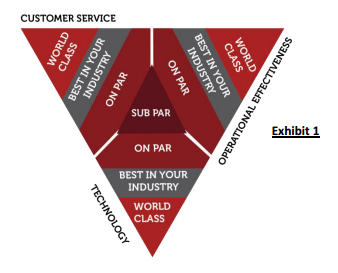A Competitive Advantage Exercise:
When planning strategy options for next year, consider that at a basic level, every company’s market differentiation focuses on one of three areas—customer service, operational effectiveness and technology/innovation.
History suggests that a company can only be known in the market for one of the three competencies at a given time. The company might be relatively strong at all three, but their true competitive advantage lies in one competency. While you can argue that every industry or market segment requires a level of performance in all three to compete, to achieve real success, a company must excel at one. Finding the right balance between the three areas to compete effectively is the hard part.
This approach to defining competitive advantage can be framed as illustrated in Exhibit 1. The three corners of the triangle represent the three core differentiators and the level of capability required to compete in the market segment. Inside each corner is the level of proficiency that a company demonstrates.
Exhibit 1

Putting The Model To Work!
The first question to consider is, “Today, at what level of market competency does my company perform—subpar to competition, on par with competition, best in industry, or world-class?”
The second question is, “Which of the three areas will become our point of difference versus our competition in the future?”
And finally, the third question is, “What does our company have to do to achieve that level of competency?”
While one company may be best in a specific industry or even world-class in one of the three areas, the same company may be on par with the rest of its industry in the other two areas—as long as it stays within the market requirements to compete, a company can even be in the subpar range.
For example, Southwest Airlines is an operations running machine. Everything they do is about driving efficiency. They are considered world-class in operational effectiveness. At the same time, they’re best in industry in customer service and on par in technology. If they’re going to invest in maintaining their difference, then they want to focus on driving efficiency and continuing to keep their prices down leveraging their existing competitive advantage.
Another example within the airline industry is Virgin Atlantic. Virgin excels at customer service and continues to be known for the high profile of its customers as a result. In recent years the company has begun to add technology to its impeccable service by upgrading its aircraft. In contrast, British Airways and Air France have traditionally led in the technology wing with aircraft such as the (now defunct) Concorde. The changing aviation market is a great example of how differentiation, brand and competitive advantage intersect in this model.
The bottom line is that a company really can’t be The Best in more than one area at a given time. Yet over time and with focus, a company can stay ahead of the competition by maintaining their unique competitive position. Consider the industries below and how some of the companies achieve great things in the marketplace by focusing on their points of difference.

Now, ask yourself, where does your company rank? Using the chart, rank your companies capabilities from ‘world-class to sub-par’ for each area.
With an understanding of where you are today, you can begin to identify where you want to go, creating clear focus and action plans around the choices you make.
Since developing new capabilities costs a lot of money, companies only develop capabilities where they can realize increased sales, margins or new customers. The case must be made for investing when and where it pays off.
When considering the future direction of your strategy, considering the following:
1. Changing strategic direction takes time, resources and focus. Be realistic about what will be required and disciplined in making the change happen and stick.
2. Keep a close eye on competitors, since markets are dynamic and changes in technology and service can happen quickly.
3. Use the voice of your customers to validate the importance of the things you plan so that they can remain your loyal customers.
4. Build a long term strategic road map so you keep your plans grounded in a deep understanding of the market, its maturity, and its trends.
5. Keep your team focused on the simple truth of what you are trying to accomplish. Maintain this thinking and set clear goals for everyone in the company.
……….
This article first appeared in LinkedIn: View article in LinkedIn.
